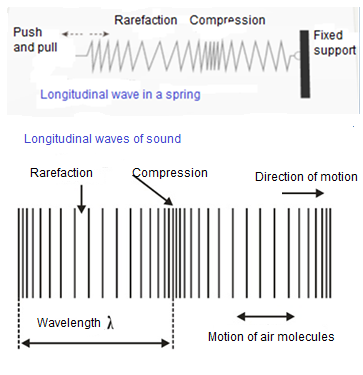Question2: Describe longitudinal and transverse waves with examples and clearly explain the difference between them.
ANSWER
Both longitudinal and transverse waves are forms of progressive (or traveling) waves, that is, they transfer energy from one place to another.
Transverse Waves
Transverse waves are defined as waves in which the particles of the medium vibrate along the line perpendicular to the direction of propagation of the wave.
The vibrating particles have time period and frequency of the source generating the waves. The portion above the mean level is called crest (or peak) and below the mean level as trough (or valley).
Examples of transverse waves
Consider a string with one end attached to a fixed support and the other end is free. When the free end is moved up and down periodically, a progressive wave is produced in the string moving to the right. The particles of the medium (string) are moving up and down with the same period normal to the direction of propagation of the wave.
Another example is of pebble dropped in a quiet pond. When the pebble is dropped in the water, a circular pattern of waves spread out. The wave is seen moving on the surface of water and the water particles (molecules) executing a vertical up-down motion which is perpendicular to the direction of motion of the wave.
Other examples of transverse waves are light waves, radio and television waves.
Longitudinal Waves
Longitudinal Waves are defined as the waves in which the particles of the medium vibrate about their mean position along the direction of propagation of the wave.
This sort of motion of the particles of the medium makes them overcrowd in some portion of the medium and under crowd in others. The overcrowd portion of the medium is called compression, while the under crowd as rarefaction. For this reason these are also called compressional waves.
Examples

Consider a spring tied on one end as shown in the figure. When the free end of the spring is pushed forward, a compression is produced in the nearby loops of the spring. The compressed loops then exert force on the loops to the right and the disturbance travels on this way. However, when the spring is pulled backward the nearby loops are rarefacted. The rarefacted loops then exert the force on loops next to them and again the disturbance moves on.
If the spring is pushed and pulled continuously, a wave is set up in the spring (alternate compressions and rarefactions) and particles of the spring are vibrating along the same direction.
One another example is of sound waves. A sound wave is produced by the compressions and rarefactions produced in the air molecules.

Pingback:Comprehensive Questions on Waves … msa – msa
Pingback:crest-trough-node-anti-node-etc – msa
Pingback:wave-motion: definition and characteristics … msa – msa
Pingback:index-cqs8-p11